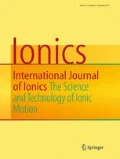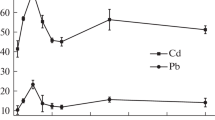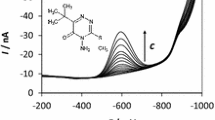Abstract
A new DP AdSV method was developed for the determination of the pesticide clothianidin (Clo) based on its nitro group reduction at the in situ renovated bismuth bulk annular band working electrode (BiABE). Crucial point of the proposed procedure is simple and fast regeneration of the BiABE’s surface in the presence of testing solution, by application of the activation potential (E act = −1.5 V) and next short accumulation potential (E acc = −0.6 V). The voltammetric behaviour of clothianidin has been investigated by cyclic voltammetry (CV). The experimental variables such as; potential and time of activation or accumulation, pH, concentration of the supporting electrolyte, DP mode parameters and influence of possible interferences on the Clo signal response, were tested. In the optimized conditions, the peak current was proportional to the concentration of Clo over the range from 0.2 to 23.4 μmol L−1 (0.050 to 5.84 mg L−1) with R = 0.9996. The calculated value of LOD was 0.047 μmol L−1 (0.012 mg L−1) (at S/N = 3), and sensitivity was 0.094 μA/μmol L−1, for 5 s of the accumulation time. The relative standard deviation for 2 μmol L−1 of Clo was 4.2% (n = 5). The presented results were obtained without any pre-concentration time. Finally, the proposed method was successfully applied for determination of Clo in the spiked tap and river waters samples with the recovery test.






Similar content being viewed by others
References
World Health Organization, Food and Agriculture Organization of the United Nations (2011) Pesticide residues in food 2010 – Joint FAO/WHO Meeting on Pesticide Residues, Rome. http://www.fao.org/docrep/013/i1949e/i1949e00.htm. Accessed 27 Feb 2017
Jeschke P, Nauen R, Schindler M, Elbert A (2011) Overview of the status and global strategy for neonicotinoids. J Agric Food Chem 59:2897–2908
Jeschke P, Nauen R (2008) Neonicotinoids-from zero to hero in insecticide chemistry. Pest Manag Sci 64:1084–1098
Elbert A, Haas M, Springer B, Thielert W, Nauen R (2008) Applied aspects of neonicotinoid uses in crop protection. Pest Manag Sci 64:1099–1105
Johnson R (2010) Honey Bee Colony Collapse Disorder, Congressional Research Service Report for Congress. https://fas.org/sgp/crs/misc/RL33938.pdf. Accessed 27 Feb 2017
Australian Pesticides and Veterinary Medicines Authority (2011) Australian evaluation of the new active clothianidin, Canberra. http://apvma.gov.au/. Accessed 27 Feb 2017
Tapparo A, Giorio C, Soldà L, Bogialli S, Marton D, Marzaro M, Girolami V (2013) UHPLC-DAD method for the determination of neonicotinoid insecticides in single bees and its relevance in honeybee colony loss investigations. Anal Bioanal Chem 405:1007–1014
Zhang Y, Xu J, Dong F, Liu X, Li X, Li Y, Wu X, Liang X, Zheng Y (2013) Simultaneous determination of four neonicotinoid insecticides residues in cereals, vegetables and fruits using ultra-performance liquid chromatography/tandem mass spectrometry. Anal Methods 5:1449–1455
Tapparo A, Giorio C, Marzaro M, Marton D, Solda L, Girolami V (2011) Rapid analysis of neonicotinoid insecticides in guttation drops of corn seedlings obtained from coated seeds. J Environ Monit 13:1564–1568
Kamel A (2010) Refined methodology for the determination of neonicotinoid pesticides and their metabolites in honey bees and bee products by liquid chromatography-tandem mass spectrometry (LC-MS/MS). J Agric Food Chem 58:5926–5931
Liu S, Zheng Z, Wei F, Ren Y, Gui W, Wu H, Zhu G (2010) Simultaneous determination of seven neonicotinoid pesticide residues in food by ultraperformance liquid chromatography tandem mass spectrometry. J Agric Food Chem 58:3271–3278
Guziejewski D, Skrzypek S, Łuczak A, Ciesielski W (2011) Cathodic stripping voltammetry of clothianidin: application to environmental studies. Collect Czechoslov Chem Commun 76:131–142
Guziejewski D, Skrzypek S, Ciesielski W (2012) Application of catalytic hydrogen evolution in the presence of neonicotinoid insecticide clothianidin. Food Anal Methods 5:373–380
Brycht M, Vajdle O, Zbiljić J, Papp Z, Guzsvány V, Skrzypek S (2012) Renewable silver-amalgam film electrode for direct cathodic SWV determination of clothianidin, nitenpyram and thiacloprid neonicotinoid insecticides reducible in a fairly negative potential range. Int J Electrochem Sci 7:10652–10665
Brycht M, Skrzypek S, Guzsvány V, Berenji J (2013) Conditioning of renewable silver amalgam film electrode for the characterization of clothianidin and its determination in selected samples by adsorptive square-wave voltammetry. Talanta 117:242–249
Guzsvány V, Papp Z, Zbiljić J, Vajdle O, Rodić M (2011) Bismuth modified carbon-based electrodes for the determination of selected neonicotinoid insecticides. Molecules 16:4451–4466
Pappl Z, Guzsvány V, Švancara I, Vytřas K (2011) Voltammetric monitoring of photodegradation of clothianidin, nitenpyram and imidacloprid insecticides using a tricresyl phosphate-based carbon paste electrode. Int J Electrochem Sci 6:5161–5171
Guzsvány V, Kádár M, Papp Z, Bjelica L, Gaál F, Tóth K (2008) Monitoring of photocatalytic degradation of selected neonicotinoid insecticides by cathodic voltammetry with a bismuth film electrode. Electroanalysis 20:291–300
Guzsvány V, Kádár M, Gaál F, Bjelica L, Tóth K (2006) Bismuth film electrode for the cathodic electrochemical determination of thiamethoxam. Electroanalysis 18:1363–1371
Armstrong KC, Tatum CE, Dansby-Sparks RN, Chambers JQ, Xue ZL (2010) Individual and simultaneous determination of lead, cadmium, and zinc by anodic stripping voltammetry at a bismuth bulk electrode. Talanta 82:675–680
Baś B, Węgiel K, Jedlińska K (2015a) The renewable bismuth bulk annular band working electrode: Fabrication and application in the adsorptive stripping voltammetric determination of nickel(II) and cobalt(II). Anal Chim Acta 881:44–53
Baś B, Węgiel K, Jedlińska K (2015b) New voltammetric sensor based on the renewable bismuth bulk annular band electrode and its application for the determination of palladium(II). Electrochim Acta 178:665–672
Węgiel K, Jedlińska K, Baś B (2016) Application of bismuth bulk annular band electrode for determination of ultratrace concentrations of thallium(I) using stripping voltammetry. J Hazard Mater 310:199–206
Tall O, Beh D, Jaffrezic-Renault N, Vittori O (2010) Electroanalysis of some nitro-compounds using bulk bismuth electrode. Int J Environ Analyt Chem 90:40–48
Bučková M, Gründler P, Flechsig GU (2005) Adsorptive stripping voltammetric detection of daunomycin at a bismuth bulk electrode. Electroanalysis 17:440–444
Prchal V, Ottenschlagerova A, Vyskocil V, Barek J (2016) Voltammetric determination of 5-nitroindazole using a bismuth bulk electrode. Anal Lett 49:49–55
Grosser DK (1994) Cyclic voltammetry simulation and analysis of reaction mechanisms. VCH Publisher, New York
Economou A (2005) Bismuth-film electrodes: recent developments and potentialities for electroanalysis. Trends Anal Chem 24:334–340
Gaál F, Guzsvány V, Bjelica L (2007) Determination of various insecticides and pharmaceuticals using differently modified glassy carbon electrode. J Serb Chem Soc 72:1465–1475
Squella JA, Bollo S, Nunez-Vergara LJ (2005) Recent developments in the electrochemistry of some nitro compounds of biological significance. Curr Org Chem 9:565–581
Acknowledgements
This work was supported by the Polish National Science Centre (Project No. 2015/19/B/ST5/01380).
Author information
Authors and Affiliations
Corresponding author
Rights and permissions
About this article
Cite this article
Węgiel, K., Baś, B. Voltammetric characteristics and determination of clothianidin using a bismuth bulk annular band electrode regenerated in situ. Ionics 23, 3187–3195 (2017). https://doi.org/10.1007/s11581-017-2105-y
Received:
Revised:
Accepted:
Published:
Issue Date:
DOI: https://doi.org/10.1007/s11581-017-2105-y




